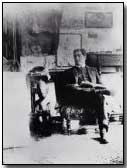Prose & Poetry - Guillaume Apollinaire
 Poet who took part in all avant-garde
movements in French literature at the beginning of the 20th century.
Poet who took part in all avant-garde
movements in French literature at the beginning of the 20th century.
Besides writing poetry, Apollinaire (1880-1918) published
semi-pornographical books; he was an innovator in the theatre of the absurd
and established Cubism as a school of painting with his study Peintres
Cubistes (1913).
A la fin tu es las de ce monde ancien
Bergère ô tour Eiffel le troupeau des ponts bêle ce matin
Tu en as assez de vivre dans l'antiquité grecque et romaine
Ici même les automobiles ont l'air d'être anciennes
La religion seule est restée toute neuve la religion
Est restée simple comme les hangars de Port-Avion...
(from Zone)
Apollinaire kept his origin secret, but he was probably born in Rome as the illegitimate son of a Polish adventurer called Angelica de Kostrowitzky, a rebellious Polish girl. His father was possibly a Swiss-Italian aristocrat, Francesco Flugi d'Aspermont. He disappeared early from Apollinaire's life, and the future poet was raised by his gambling mother in Italy, in Monaco, on the French Riviera, and in Paris.
In his youth Apollinaire assumed the identity of a Russian prince. He received a French education at the Collège Saint-Charles in Monaco, and afterwards in schools in Cannes and Nice.
At the age of 20 Apollinaire settled in Paris where he worked for a time for a bank. Among his friends were such artist as Pablo Picasso, André Derain, playwright Alfred Jarry, and the painter Marie Laurencin, who was his lover. At the age of twenty-one he travelled in Germany, where he was introduced to German romantic poetry and to the torments of unrequited love.
Apollinaire edited a number of reviews, published satirical and semi-pornographical texts, and proclaimed that the writing of de Sade would dominate the 20th-century. His first collection of poems, L'enchanteur Pourrissant, appeared in 1909, but it was in 1913 with the publication of Alcools when he gained fame as a major, highly original poet. L'enchanteur pourrissant was illustrated by Derain. The prose-poem depicted the entombment of Merlin the Enchanter by his love. From his sufferings Merlin creates a new world of poetry. Alcools combined classical verse forms with modern imagery, involving transcriptions of street conversations overheard by change and the absence of punctuation. It opened with the poem Zone, in which the tormented poet wanders through streets after the loss of his mistress. Among its other famous poems are 'Le pont Mirabeau' and 'La chanson du mal-aime.'
When cubism had become a powerful force, Apollinaire published The Cubist Painters, which explored the theory of cubism and analysed psychologically the chief cubists and their works. According to Apollinaire, art is not a mirror held up to nature, so cubism is basically conceptual rather than perceptual. By means of the mind, one can know the essential transcendental reality that subsists 'beyond the scope of nature'. Ten days after the appearance of the book, Apollinaire deserted cubism for Orphism. The concept was also invented by him and described 'the art of painting new structures out of elements that have not been borrowed from the visual sphere but have been created entirely by the artist himself, and have been endowed by him with the fullness of reality.' Among Orphicist artist were Robert Delaunay, Fernand Léger, Francis Picabia, and Frantisek Kupka.
Disenchanted with his reputation as a dangerous foreigner and thief - in 1911 he had been detained for a week on suspicion of stealing the Mona Lisa - he took out French nationality and enlisted in the infantry. He fought on the front in Champagne until 1916, when he received a head wound. In 1914 Apollinaire had a short-lived affair with Louise de Coligny, then with a schoolteacher called Madeleine Pagès, to whom he became engaged and the he met Jacqueline Kolb, whom he married in 1918.
Le Poete Assassine (1916, The Poet Assassinated) was a collage of the great Croniamantal from his birth to his breakthrough as a poet and death at the hand of a mob. Apollinaire pieced the work together from pieces which he had saved for years. Its a broken, episodic narrative changes from farcical to exalted.
'Others profited from the intermission by vomiting wildly, their eyes bulging out of their heads; their neighbours encouraged them with an imperturbable seriousness. Hannes Irlbeck, who had gotten back on his feet, but not without great effort, sniffed and murmured. "There's no more beer in Munich."'
Apollinaire's play The Breast of Tiresias was staged in 1917. He called the play Surrealist, making the term known. The play combined his own sexual obsessions with a satirical exploitation of Greek legend and ironic preoccupation with the low birth rate in 19c-20c France. It was made into an opera (1947) by Francis Poulenc.
Apollinaire died of influenza in the great epidemic of 1918, on November 9, in Paris. Experimental Calligrammes (1918), Apollinaire's poetic record of his war experiences, was published a few months before his death. André Breton, Tristan Tzara, Paul Éluard, and Louis Aragon and other poets of the younger generation answered to its apocalyptic call for investigation of the new worlds.
Cubism left its marks on several literary works and authors. Max Jacon, André Salmon, Pierre Reverdy, and Gertrude Stein were intimately connected with the cubist painters. In prose, critics have seen cubist aesthetics in André Gide's novel Les Fauxmonnayeurs (1925). Apollinaire's stature has continued to grow since his death, as the precursor of surrealism and as a modernist poet.
Article contributed by Petri Liukkonen, website Author's Calendar.
In slang a "beetle" was a landing craft for 200 men.
- Did you know?
